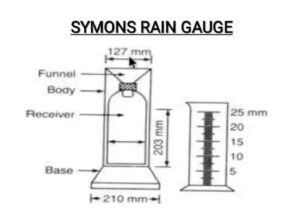Precipitation and different type of rain gauge
Dr. Smriti Shukla
PhD student, Division of Physiology and Climatology IVRI, Izatnagar, Bareilly, U.P.
Email id: shuklasmriti2415@gmail.com
- Three major part of global water cycle is
- Evaporation
- Condensation
- Precipitation
- Precipitation: –
- It is one of the components of water cycle
- It is the process by which any liquid or frozen water formed in atmosphere falls back to earth and so completes the water cycle
- It comes on earth in many form i.e. rain, sleet, snow, hail
- The form in which vapor will change and will get precipitated, depends on temperature of clouds and surface of earth
- Precipitation is always fresh water, even when the water originated from the ocean. This is because sea salt does not evaporate with water.
- However, in some cases, pollutants in the atmosphere can contaminate water droplets before they fall to the earth. The precipitation that results from this is called acid rain
- Particles of dust or smoke in the atmosphere are essential for precipitation. These particles, called “condensation nuclei,” provide a surface for water vapor to condense upon. This helps water droplets gather together and become large enough to fall to the earth.
Rain gauge:
- Rain gauge is a meteorological instrument that is used to measure the precipitation in a given period of time per unit area. It is also known by the names of udo meter, pluviometry, and ombrometer.
- The instrument is consisting of a collection container that is placed in an open area that will serve the purpose of a recipient.
- Based on assumption that the same amount of rain precipitation is occurring all around the container
- Container should be of adequate size, being neither too small nor too big.
- Most popular design being a standard cylindrical vessel. It has been made in such a way that the container does not allow the water to be evaporated before the measurement has taken place.
- The precipitation is measured in millimeters (mm) / inches
- First rain fall record by ancient Greeks, about 500 B.C In 1662 Cristopher Wren created, first Tipping – bucket rain gauge in Britain

Fig. 1. Rain guage
Kind of rain gauge: –
- Non-recording rain gauges
- Recording rain gauges
Non-recording rain gauge: –
Fig. 2. Non recording type rain gauge
- It gives only total rainfall occurred during particular time period but do not give hourly rainfall
- Time of onset, time of cessation and intensity of rain fall at particular instant can’t be known by this rain gauge
- In other word non recording type gives total rain fall but recording type gives rain fall at any time
Symons rain gauge:
- Non-recording rain gauge is “Symons Rain gauge”.
- Most commonly used in India
- Recording taken at 8.30 am (IST)
- In case of heavy rain fall intermediate reading taken at 5.30 pm (IST)
- During heavy rain fall three or four times recording done as receiver fills by water, but last recording done at 8.30 am and sum of measurement taken for previous 24 hr
- It is consisting of receiver and funnel
- Receiver is cylindrical metal (zink) bottle

Fig. 3. Symons rain gauge
Recording type rain gauge: –
- This is also called self – recoding, automatic or integrating type of rain gauge
- This type of rain gauge has automatic mechanical arrangement consist of clockwork, a drum with graph paper fixed around it and a pencil point which draws the mass curve of rain fall
- From this mass curve, the depth of rain falls in given time, the rate of intensity of rain falls at any instant, time of onset and time of cessation of rain fall can be known So well calibrated system having equipment to record rain fall at different time interval found in this.

Fig. 4 Recording type rain gauge




